
Lupinus polyphyllus, the large-leaved lupine, big-leaved lupine, many-leaved lupine, blue-pod lupine, or, primarily in cultivation, garden lupin, is a species of lupine (lupin) native to western North America from southern Alaska and British Columbia and western Wyoming, and south to Utah and California. It commonly grows along streams and creeks, preferring moist habitats.
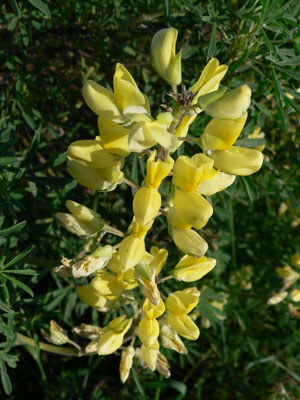
Lupinus arboreus, the yellow bush lupine (US) or tree lupin (UK), is a species of flowering plant in the legume family Fabaceae.
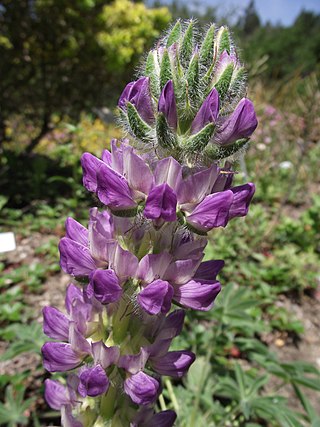
Lupinus microcarpus, the wide-bannered lupine or chick lupine, is a species of lupine native to western North America from southwestern British Columbia south through Oregon and California, including the Mojave Desert, and into Baja California. There is also a disjunct population in South America, with locations in central Chile and western Argentina.

Lupinus texensis, the Texas bluebonnet or Texas lupine is a species of lupine found in Texas, Louisiana, Arkansas and the Mexican states of Coahuila, Nuevo León, and Tamaulipas. With other related species of lupines also called bluebonnets, it is the state flower of Texas.

Lupinus sparsiflorus is a species of lupin native to North America. In the United States it occurs in California, Nevada, Arizona and Utah, and in Mexico it is found in Baja California and Sonora. Other common names include Mojave lupine, a name it shares with Lupinus odoratus.

Lupinus perennis is a flowering plant in the family Fabaceae.

Lupinus excubitus is a species of lupine known as the grape soda lupine. Its common name refers to its sweet scent, which is said to be very reminiscent of grape soda. This species and its variants are found in Southwestern United States, especially in California and Nevada, e.g., Death Valley and Joshua Tree National Parks, and northwestern Mexico.
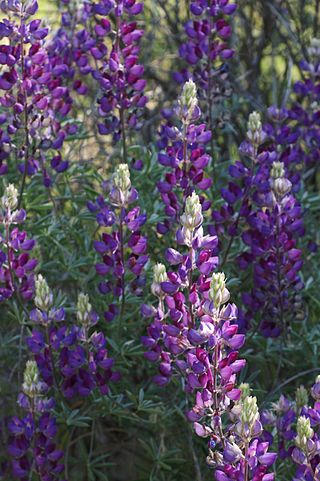
Lupinus albifrons, silver lupine, white-leaf bush lupine, or evergreen lupine, is a species of lupine (lupin). It is native to California and Oregon, where it grows along the coast and in dry and open meadows, prairies and forest clearings. It is a member of several plant communities, including coastal sage scrub, chaparral, northern coastal scrub, foothill woodland, and yellow pine forest.
Lupinus antoninus is a rare species of lupine known by the common name Anthony Peak lupine. It is endemic to northern California, where it is known from only four occurrences in the North Coast Ranges, including near Anthony Peak.

Lupinus argenteus is a species of lupine known by the common name silvery lupine. It is native to much of western North America from the southwestern Canadian provinces to the southwestern and midwestern United States, where it grows in several types of habitats, including sagebrush, grassland, and forests.

Lupinus cervinus is a species of lupine known by the common name Santa Lucia lupine. It is endemic to the Santa Lucia Mountains in the Central Coast Ranges in California, where it is an uncommon member of the flora in the mountain forests. This is a hairy gray-green perennial herb growing up to 30–70 centimetres (12–28 in) tall. The erect stem is surrounded by clusters of spreading leaves. Each palmate leaf is made up of 4 to 8 leaflets up to 8 centimetres (3.1 in) long and 3 centimetres (1.2 in) wide, which is wider than the leaflets of most lupines. The inflorescence bears many flowers, sometimes in whorls, each between 1 centimetre (0.39 in) and 2 centimetres (0.79 in) long. The flower is often bright pink, but may be shades of blue to nearly white. There is often a yellow patch on the banner. The fruit is a hairy legume pod up to 6 centimetres (2.4 in) long.
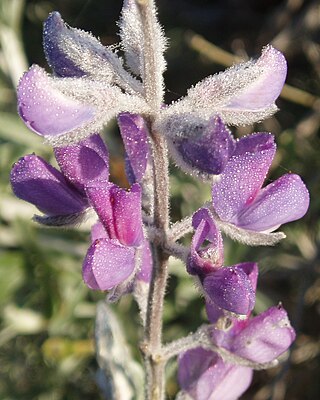
Lupinus chamissonis is a species of lupine known by the common name Chamisso bush lupine. It is endemic to California, where it is known from most of the length of the coastline. It grows in sand dunes and other immediate coastal habitat.
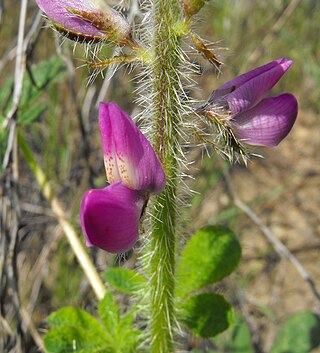
Lupinus hirsutissimus is a species of lupine known by the common names stinging annual lupine or stinging lupine. It is native to the coastal mountains of Baja California and Southern California as far north as the San Francisco Bay Area. It grows on dry mountain slopes, including areas that have recently burned, and chaparral and woodlands habitats.
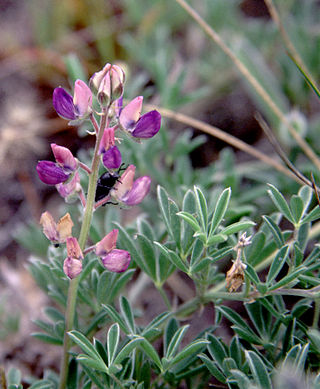
Lupinus littoralis is a species of lupine known by the common name seashore lupine. It is native to the coastline of western North America from British Columbia to northern California, where it grows in sandy habitat.

Lupinus obtusilobus is a species of lupine also known by the common names bluntlobe lupine and satin lupine. It is native to high mountains of northern California, including the North Coast Ranges, the Klamath Mountains, and the northernmost Sierra Nevada. It grows in various types of mountain habitat, sometimes carpeting meadows with its purple blooms in the spring. It is a perennial herb growing erect or decumbent along the ground, its stem 15–30 centimetres (5.9–11.8 in) long. Each palmate leaf is made up of 6 to 7 leaflets up to 5 centimetres (2.0 in) long. The herbage is coated in silvery silky hairs. The inflorescence is a small raceme with a few whorls of flowers each just over a centimeter long. The flower is blue to purple with a yellowish patch on its banner. The fruit is a silky-haired legume pod up to 4 centimetres (1.6 in) long.

Lupinus pratensis is a species of lupine known by the common name Inyo meadow lupine. It is endemic to California, where it grows in the central Sierra Nevada and adjacent plateau and valleys to the east. It grows in relatively moist habitat, such as streambanks and spring meadows. This is an erect perennial herb growing 30–70 centimetres (12–28 in) tall. Each palmate leaf is made up of 5 to 10 narrow leaflets sometimes exceeding 10 centimetres (3.9 in) long. The leaves are borne on long petioles which can reach 25 centimetres (9.8 in) in length. The herbage is green and coated in thin hairs. The inflorescence is a dense raceme of many flowers each around a centimeter long. The flower is dark blue or purple with a reddish or orange patch on its banner. The fruit is a hairy legume pod around 2 centimetres (0.79 in) long.

Bluebonnet is a name given to any of a number of purple-flowered or blue-flowered species of the genus Lupinus predominantly found in southwestern United States and is collectively the state flower of Texas. The shape of the petals on the flower resembles the bonnet worn by pioneer women to shield them from the sun. Species often called bluebonnets include:
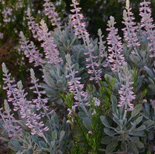
Lupinus aridorum is a rare species of lupine known by the common name scrub lupine. It is endemic to Florida in the United States, where there were 10 known populations remaining in 2003. Fewer than 6000 individual plants were counted. It is threatened by the loss and degradation of its habitat. The scrub lupine is a federally listed endangered species of the United States.

Lupinus sericeus is a species of flowering plant in the legume family known by the common name silky lupine or Pursh's silky lupine. It is native to western North America from British Columbia to Arizona and east to Alberta and Colorado.

Lupinus lepidus, the Pacific lupine, prairie lupine or dwarf lupine is a perennial herbaceous plant in the pea family (Fabaceae) native to western North America.


















